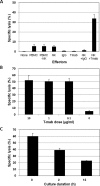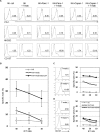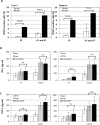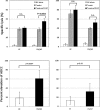Anti-CD137 monoclonal antibody enhances trastuzumab-induced, natural killer cell-mediated cytotoxicity against pancreatic cancer cell lines with low human epidermal growth factor-like receptor 2 expression
- PMID: 30596643
- PMCID: PMC6312288
- DOI: 10.1371/journal.pone.0200664
Anti-CD137 monoclonal antibody enhances trastuzumab-induced, natural killer cell-mediated cytotoxicity against pancreatic cancer cell lines with low human epidermal growth factor-like receptor 2 expression
Abstract
Because human epidermal growth factor-like receptor (HER) 2 is expressed on the surface of human pancreatic carcinoma cells to varying degrees, trastuzumab, an anti-HER2 monoclonal antibody (mAb), is expected to exert antibody-dependent, natural killer (NK) cell-mediated cytotoxicity (ADCC) against the cells. However, some reports found that the effect of trastuzumab against human pancreatic carcinoma cells was limited because most express only limited HER2. We examined whether anti-CD137 stimulating mAb could enhance trastuzumab-mediated ADCC against Panc-1, a human pancreatic cancer cell line with low HER2 expression, in vitro. Supplementation of anti-CD137 mAb could improve trastuzumab-mediated ADCC against Panc-1 which was insufficient without this stimulating antibody. The ADCC differed in individual cells, and this was related to the expression of CD137 on the surface of NK cells after trastuzumab stimulation in association with the Fcγ-RIIIA polymorphism. NK cells with Fcγ-RIIIA-VV/VF showed high levels of ADCC against Panc-1, but those with Fcγ-RIIIA-FF did not show optimal ADCC. In addition, trastuzumab-mediated ADCC against the human pancreatic cancer cell line Capan-1 with high HER2 expression was generally high and not affected by the Fcγ-RIIIA polymorphism. These results demonstrated that in Fcγ-RIIIA-VV/VF-carrying healthy individuals, trastuzumab plus αCD137 mAb could induce effective ADCC against HER2-low-expressing pancreatic cancer cell lines, and that such an approach may result in similar findings in patients with pancreatic cancer.
Conflict of interest statement
The authors have declared that no competing interests exist.
Figures








Similar articles
-
Role of Fcγ receptors in HER2-targeted breast cancer therapy.J Immunother Cancer. 2022 Jan;10(1):e003171. doi: 10.1136/jitc-2021-003171. J Immunother Cancer. 2022. PMID: 34992090 Free PMC article. Review.
-
Trastuzumab-Mediated Antibody-Dependent Cell-Mediated Cytotoxicity (ADCC) Enhances Natural Killer Cell Cytotoxicity in HER2-Overexpressing Ovarian Cancer.Int J Mol Sci. 2024 Oct 31;25(21):11733. doi: 10.3390/ijms252111733. Int J Mol Sci. 2024. PMID: 39519282 Free PMC article.
-
Tribody [(HER2)2xCD16] Is More Effective Than Trastuzumab in Enhancing γδ T Cell and Natural Killer Cell Cytotoxicity Against HER2-Expressing Cancer Cells.Front Immunol. 2018 Apr 19;9:814. doi: 10.3389/fimmu.2018.00814. eCollection 2018. Front Immunol. 2018. PMID: 29725336 Free PMC article.
-
Canine non-B, non-T NK lymphocytes have a potential antibody-dependent cellular cytotoxicity function against antibody-coated tumor cells.BMC Vet Res. 2019 Oct 14;15(1):339. doi: 10.1186/s12917-019-2068-5. BMC Vet Res. 2019. PMID: 31610784 Free PMC article.
-
Focusing on NK cells and ADCC: A promising immunotherapy approach in targeted therapy for HER2-positive breast cancer.Front Immunol. 2022 Dec 19;13:1083462. doi: 10.3389/fimmu.2022.1083462. eCollection 2022. Front Immunol. 2022. PMID: 36601109 Free PMC article. Review.
Cited by
-
Update on current and new potential immunotherapies in breast cancer, from bench to bedside.Front Immunol. 2024 Feb 15;15:1287824. doi: 10.3389/fimmu.2024.1287824. eCollection 2024. Front Immunol. 2024. PMID: 38433837 Free PMC article. Review.
-
Antibody-dependent cellular cytotoxicity-inducing antibodies enhance the natural killer cell anti-cancer response against patient-derived pancreatic cancer organoids.Front Immunol. 2023 Jul 14;14:1133796. doi: 10.3389/fimmu.2023.1133796. eCollection 2023. Front Immunol. 2023. PMID: 37520563 Free PMC article.
-
Combined treatment with anti-HER2/neu and anti-4-1BB monoclonal antibodies induces a synergistic antitumor effect but requires dose optimization to maintain immune memory for protection from lethal rechallenge.Cancer Immunol Immunother. 2022 Apr;71(4):967-978. doi: 10.1007/s00262-021-03120-1. Epub 2022 Jan 6. Cancer Immunol Immunother. 2022. PMID: 34988585 Free PMC article.
-
Role of Fcγ receptors in HER2-targeted breast cancer therapy.J Immunother Cancer. 2022 Jan;10(1):e003171. doi: 10.1136/jitc-2021-003171. J Immunother Cancer. 2022. PMID: 34992090 Free PMC article. Review.
-
The dark side of immunotherapy: pancreatic cancer.Cancer Drug Resist. 2020 May 11;3(3):491-520. doi: 10.20517/cdr.2020.13. eCollection 2020. Cancer Drug Resist. 2020. PMID: 35582441 Free PMC article. Review.
References
-
- Wilkowski R, Wolf M, Heinemann V. Primary advanced unresectable pancreatic cancer. Recent Results Cancer Res. 2008;177:79–93. . - PubMed
-
- Ueno H, Ioka T, Ikeda M, Ohkawa S, Yanagimoto H, Boku N, et al. Randomized phase III study of gemcitabine plus S-1, S-1 alone, or gemcitabine alone in patients with locally advanced and metastatic pancreatic cancer in Japan and Taiwan: GEST study. J Clin Oncol. 2013;31:1640–8. 10.1200/JCO.2012.43.3680 . - DOI - PubMed
MeSH terms
Substances
Grants and funding
LinkOut - more resources
Full Text Sources
Other Literature Sources
Medical
Research Materials
Miscellaneous

